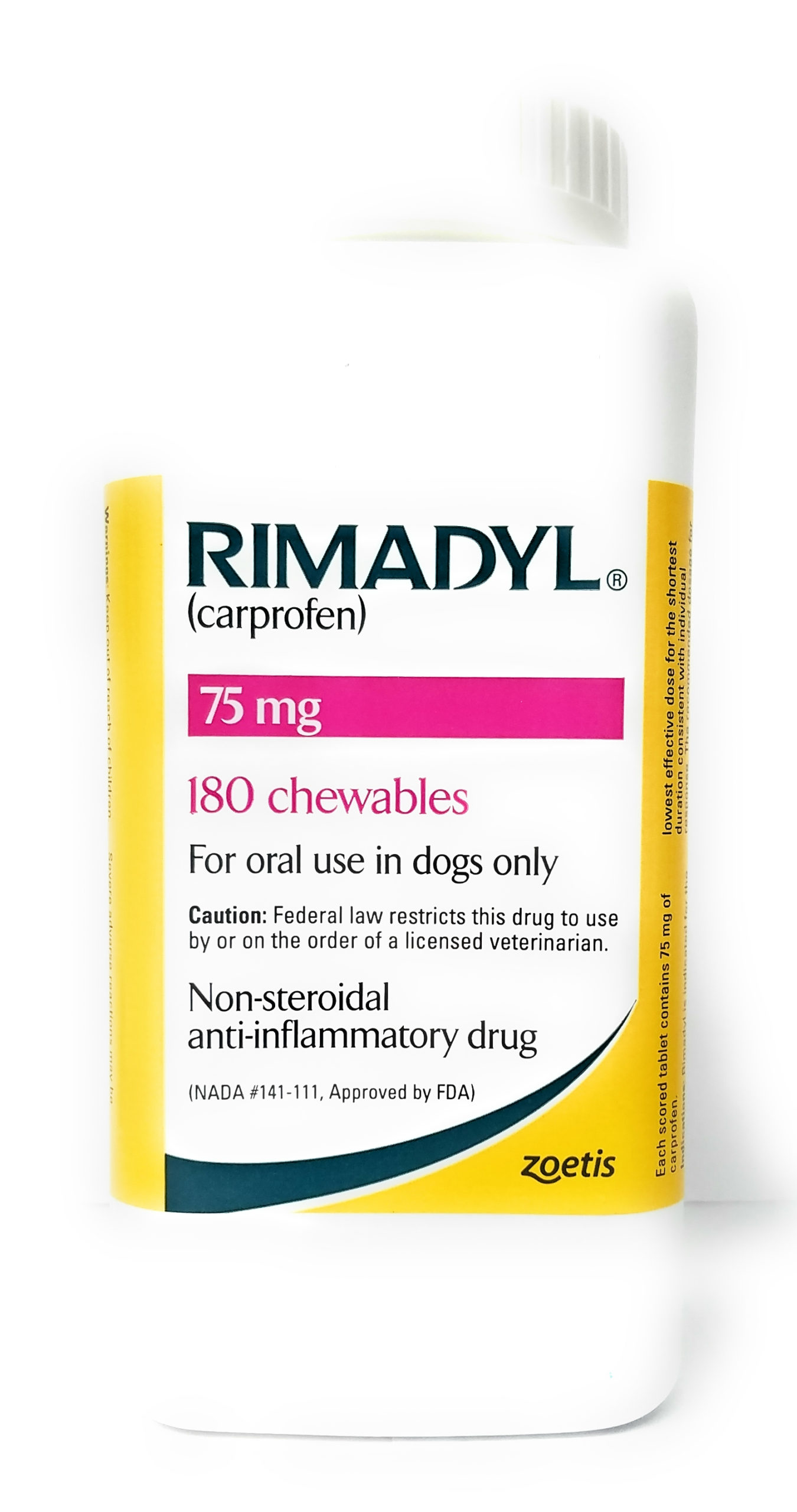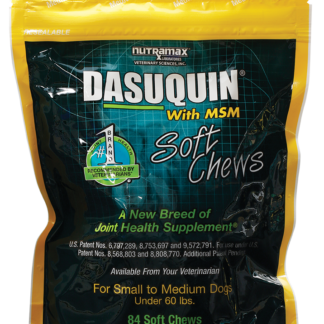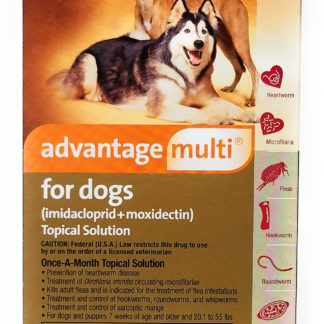Description
What is Rimadyl?:Rimadyl® (carprofen) is a non-steroidal anti-inflammatory drug (NSAID) developed and approved specifically for use in dogs. Indicated for the relief of pain and inflammation, Rimadyl has been shown to be clinically effective for the relief of signs associated with arthritis. Benefits: Canine non-steroidal anti-inflammatory drug (NSAID) in oral dosage form Selectively inhibits cyclooxygenase (COX)-2, which generates prostaglandins involved in inflammation. (In vitro, clinical relevance has not been shown). Once-daily dosage provides anti-inflammatory and analgesic effects for 24 hours. What is Rimadyl used for?:RIMADYL® CHEWABLES are approved for: Pain and inflammation associated with osteoarthritis in dogs. Control of postoperative pain associated with soft-tissue and orthopedic surgeries in dogs. What does Rimadyl do for a dog with arthritis? Rimadyl relieves arthritis pain, allowing for increased activity and freedom of movement, thereby improving a dog's quality of life. And, the increased activity helps maintain healthy weight, which helps slow down the progression of the disease. First and most widely used veterinary NSAID approved in the U.S. for canine use. Chewable tablets are scored and available in three strengths for convenient dosing. How do I give it to my dog? Rimadyl is available as a scored caplet or chewable tablet. Both are administered orally in 25, 75, and 100 mg doses. Rimadyl also comes in an injectable formula that your veterinarian can administer in the hospital or clinic. How much Rimadyl do I give my dog? RIMADYL Chewable Tablets are scored and contain 25 mg, 75 mg or 100 mg of carprofen per caplet or tablet. Each Chewable Tablet size is packaged in bottles containing 7, 14, 30, 60 or 180 tablets. Dosage and Administration The recommended dosage for oral administration to dogs is 2 mg/lb (4.4 mg/kg) of body weight daily. Total daily dose may be administered as 2 mg/lb of body weight once daily or divided and administered as 1 mg/lb (2.2 mg/kg) twice daily. For control of postoperative pain, administer approximately 2 hours before the procedure. Caplets/tablets are scored and dosage should be calculated in half-caplet/tablet increments. ;Are there any side effects associated with Rimadyl? As with other pain relievers in this class, rare but serious digestive and liver side effects may occur. Signs of Rimadyl intolerance may include appetite loss, vomiting and diarrhea. Serious adverse reactions associated with this drug class can occur without warning and in rare situations result in death. If these signs occur, discontinue Rimadyl therapy and contact your veterinarian.; Of course, regular monitoring is required for pets on any medications. Rimadyl has been safely used in over 6 million dogs in the US and 10 million dogs worldwide. Signs of Rimadyl intolerance may include appetite loss, vomiting and diarrhea, which could indicate rare but serious side effects involving the digestive tract, liver or kidneys. Serious adverse reactions associated with this drug class can occur without warning and in rare situations result in death. If these signs occur, discontinue Rimadyl therapy and contact your veterinarian. What should I do if I suspect my dog has arthritis? Precautions See label instructions for complete precautions, warnings and safety information. Federal law restricts this drug to use by or on the order of a licensed veterinarian. RIMADYL should not be used in dogs exhibiting previous hypersensitivity to carprofen. As a class, COX-inhibitory NSAIDs may be associated with gastrointestinal and renal toxicity. When NSAIDs inhibit prostaglandins that cause inflammation, they may also inhibit prostaglandins which maintain normal homeostatic function. The most frequently reported effects have been gastrointestinal signs. RIMADYL, like other drugs of its class, is not free from adverse reactions. Owners should be advised of the potential for adverse reactions and be informed of the clinical signs associated with drug intolerance. Serious adverse reactions associated with this drug class including but not limited to gastrointestinal, renal and hepatic signs can occur without warning and in rare situations result in death. Owners should be advised to discontinue RIMADYL therapy and contact their veterinarian immediately if signs of intolerance are observed. The use of parenteral fluids during surgery should be considered to reduce the potential risk of renal complications when using NSAIDs perioperatively. The safe use of RIMADYL in dogs less than 6 weeks of age, pregnant dogs, dogs used for breeding purposes, or in lactating bitches has not been established. Studies to determine the activity of RIMADYL given concomitantly with other protein-bound or similarly metabolized drugs have not been conducted. Drug compatibility should be monitored closely in patients requiring additional therapy. Concurrent use of RIMADYL with other anti-inflammatory drugs, such as corticosteroids and NSAIDs, should be avoided or very closely monitored. Keep out of reach of children. Not for human use. For use in dogs only. ;What you should know about Arthritis and Your Dog: If your dog could talk, being his best friend would be a lot easier. But he can't tell you that his knees stiffen up after he plays too long or that his hips hurt when he goes up or down stairs. He's counting on you to recognize signs of pain and decreased mobility and to have your veterinarian diagnose and treat the condition. To provide the best care for your best friend, take a few minutes to learn the facts, the signs and how your dog can find relief from painful arthritis. If your dog could talk, he'd thank you for it. Know the Facts About Arthritis Arthritis is a painful, degenerative joint disease that affects one in five adult dogs in the United States (1). Arthritis is even more common among older dogs. Unfortunately, many of the cases go undiagnosed because owners attribute the subtle changes in their dogs to âold ageâ or âslowing down.â Know the Signs of Arthritis Pain Any dog can develop arthritis, and knowing the signs and symptoms of pain will help you determine when your dog may need veterinary attention. Could your dog have arthritis? Ask yourself these simple questions: Does your dog tire easily or lag behind during long walks? Does your dog limp or appear stiff after activity? Is your dog reluctant to climb steps or jump up? Is your dog slow to rise from a resting position? If you answered âyesâ to even one of these questions, it's possible that your dog is suffering from painful arthritis. We recommend that you ask your veterinarian to examine your dog for arthritis. The sooner your dog is properly diagnosed and treated, the sooner he or she can overcome the pain and become an active member of your family again. Know that Your Dog Doesn't Have to Suffer If your dog has arthritis, pain relief is possible with Rimadyl®. Rimadyl for dogs has been proven clinically effective for the relief of pain associated with arthritis. Already, Rimadyl has helped more than 10 million dogs find relief from the pain of arthritis (2). And without pain, your pet can move freely and happily again. If your dog exhibits any of the signs of arthritis pain, it's important to schedule an exam with your veterinarian. He or she can diagnose and recommend the appropriate treatment program for your dog's arthritis. Often, this program may include dietary changes, exercise and a non-steroidal anti-inflammatory drug (NSAID) like Rimadyl to alleviate your dog's pain. Together, these elements can help relieve joint stress and build muscle strength to make sure your dog remains an active part of your family. Does weight have an effect on arthritis? Excess weight can put undue stress on the joints, ligaments and cartilage. So an obese dog with arthritis is likely to experience more pain than a dog that's trim. If your dog is overweight, ask your veterinarian about diets to help your dog lose weight safely. What about exercise for my dog with arthritis? When arthritis makes it painful for your dog to move, chances are he'll be less active. But inactivity can lead to problems too, such as decreased flexibility, joint stiffness, loss of muscle strength, and weight gain. The key is moderation: providing a healthy level of exercise that doesn't put too much strain on your pet's joints. Low-impact exercise, such as leash walking and swimming, can increase muscle strength and help stabilize joints. Start your dog's exercise program slowly to give your dog time to get in shape. Begin with several short walks, interspersed with rest periods. If your dog seems to experience more pain after exercise, decrease the exercise time by half. As muscle strength increases, gradually increase the length of your walks. But before starting any exercise program, discuss it with your veterinarian first, to ensure that it's the right program for your dog. Of course, if your dog is overweight, don't overdo exercise and stress the joints until weight loss occurs. And if your dog has a pre-existing condition that puts him at risk for arthritis, such as a torn cruciate ligament, talk to your veterinarian about correcting the condition before starting an exercise program. Exercising a dog with an unstable joint from a torn cruciate ligament will only speed the development of arthritis. Do you have any tips about exercising my dog? Try to make exercise a regular part of your dog's routine. Take frequent, short walks throughout the week, rather than one long hike on the weekend. Encourage swimming if your dog enjoys it. Swimming gives your dog a great workout with minimal stress on joints. Avoid exercise that involves jumping and leaping, especially for large dogs. The impact from jogging or leaping for a Frisbee is very hard on your pet's joints. If your dog tends to overdo it, keep him on a leash. Playful activities with other pets can help your dog get exercise. Cover slippery floors with rugs to make sure your dog has firm footing. Make sure you and your dog drink plenty of water before, during and after activity. Avoid exercising during the hottest parts of the day. Early mornings, late afternoons and evenings are best. Stay off hot sidewalks and pavement. If it's too hot for your bare feet, it's probably too hot for your dog's paws. Watch for signs that your dog is working too hard: rapid breathing, bright-red gums and lagging behind may indicate fatigue. If you have any questions about you or your pet's ability to engage in certain activities, contact your physician or your veterinarian. Is there anything else I can do to make my dog more comfortable? Gentle massage can be used to increase blood flow to the arthritic areas before activity, and to decrease stiffness after activity. Ask your veterinarian to show you how to correctly massage around affected joints. Applying heat to the joint can help relieve muscle spasm and pain. Just soak a towel in warm water, and apply to the joint for 10 minutes, two to three times a day. Be careful with heat – if the heat pack is too warm, it can irritate the skin. If you notice swelling in the joint area, it is better to apply a cold pack, or ice wrapped in a towel, for 15-20 minutes, three times a day. Also be careful with cold packs. If they are too cold, or are used for too long, they can irritate the skin. It's important to talk to your veterinarian if you see signs of joint swelling. Like people, dogs with arthritis can experience more discomfort when in a cold, damp environment. Keeping your dog in a warm, dry environment will help increase his comfort. An orthopedic bed may also help relieve some of your dog's morning stiffness. A bed with soft, thick padding will help cushion bones. A circulating warm-water heating pad under the blanket can provide added warmth. To avoid burning the skin, never place your dog directly on the heating pad. What you need to know … Professionals from Pfizer Animal Health answer your frequently asked questions. IF you would like more information please go to www.64x6h4nj6xf4n Here is a collection of the most common types of questions posed to Pfizer Animal Health regarding arthritis, its causes, and its treatments: Q: What are the first steps to take if I suspect my dog has arthritis? A: If your dog shows signs of arthritis pain it is important to schedule an immediate exam with your veterinarian. He or she can diagnose and recommend the appropriate canine arthritis program for your dog. Often, this program may include dietary changes, exercise, and a non-steroidal inflammatory drug (NSAID), such as Rimadyl®, to alleviate your dog's pain. Together, these elements can help relieve joint stress and build muscle strength to make sure your dog remains an active part of the family. Q: What does Rimadyl; do for a dog with arthritis? A: Rimadyl relieves arthritis pain and inflammation, allowing for increased activity and freedom of movement, thereby improving a dog's quality of life. Increased activity helps maintain healthy weight, which helps slow down the progression of the disease. Q: Does weight have an effect on arthritis? A: Excess weight can put undue stress on joints, ligaments, and cartilage. So an obese dog with arthritis is likely to experience more pain than a dog that is trim. If your dog is overweight, ask your veterinarian about diets to help your dog lose weight safely. Q: Beyond medicine, diet, and exercise, what else can be done to make a dog with arthritis more comfortable? A: Ask your veterinarian how to correctly massage affected joints. Some dogs find relief from gentle massage because it can increase blood flow and decrease stiffness after activity. Additionally, dogs with arthritis can experience more discomfort when in a cold, damp environment; keeping your dog in a warm, dry environment will help decrease discomfort. Rimadyl is a non-steroidal, anti-inflammatory medication available only by prescription through your veterinarian. It comes in caplets and in easy-to-give chewable tablets that dogs love. Signs of Rimadyl intolerance may include appetite loss, vomiting, and diarrhea, which could indicate side effects involving the digestive tract, liver, or kidneys. Some of these side effects, like those of other NSAID-class medications, may occur without warning and, in rare situations, may be serious, resulting in hospitalization or even death. In field use, the reported rate of all side effects for Rimadyl has been less than 1 percent. If these signs occur, discontinue Rimadyl therapy and contact your veterinarian. See the âimportant information for dog ownersâ section of the full prescribing information. For more information on Rimadyl and arthritis in dogs, call 1-800-720-DOGS. Rimadyl rebate form available at: www.rimadyl.com/rebateform.aspx Rimadyl 75mg Chewable Tablets – 60 Count Bottle. I do not receive this product or any others in exchange for this article, I do get a commission for readers clicking the buy now links which helps to differ the cost of hosting this blog and I sincerely hope this article site helps you with your search for Vet Approved Rx products.








